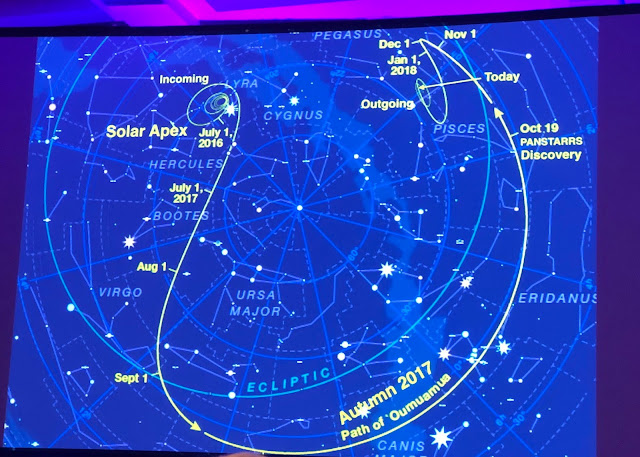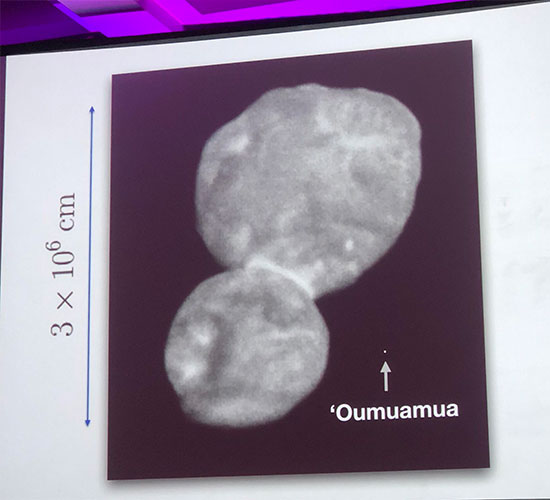Well this week we are in Seattle for the 233rd American Astronomical Society (AAS) Meeting. It is about 10 degrees colder than southern California and it has a light rain periodically. Luckily, it is just a 2 minute walk, only about 1/2 minute, outside in the weather from the hotel to the conference center.
 |
| Just a 2 minute walk to the 233rd AAS meeting at the Washington State Conference Center (Source: Palmia Observatory) |
But, before reporting some brief summary of the first day of the conference, we need to put forward a neat concept in meteorology, that I had not heard of before, which is due to the rotation of the Earth, you can also tell where the high and low pressure regions are located, simply by your orientation. In the northern hemisphere, if the wind is at your back, the high pressure area will always be located some distance from your right side.
 |
| With the wind to your back, the high pressure area is always on your right (Source: Horace Byers, General Meteorology) |
This neat description is found in a pretty good book for physicist wannabes, who while waiting for clear weather for astronomical observing, can take advantage of the cloudy skies to do a little studying of meteorology. After all it makes sense given how often our nighttime observing is clouded out!
 |
| Pretty good introduction to the science of meteorology for physicist wannabes (Source: Horace Byers) |
Ok, back to the 233rd AAS meeting. The Plenary Prize Lecture for the Kavli Foundation Lectureship was given by Greg Laughlin, Yale U, with support from Ka'iu Kimura, 'lmiloa Center, on the "Color out of Space: Oumuamua's Mysterious Visit to the Solar System.
 |
| First plenary session about Oumuamua and how it was named (Source: G. Laughlin and K. Kimura, 233rd AAS meeting) |
Remember that Oumuamua is the strange visitor that came from outside of our solar system and was deflected by our sun but not bound to the sun gravitationally. How is it known to be from outside? Because measurements of the Keplerian elements show that it has eccentricity greater than one. It is just passing though, never to return.
 |
| Oumuamua's one time visit through our solar system (Source: Greg Laughlin, Yale U, at 233rd AAS meeting) |
The name of the object comes from the ancient Hawaiian native practice of naming things, and in this case means something like "visitor from afar". Given how important the location in Hawaii is to modern astronomical observatories, and how it was first discovered by the PanSTARRS telescope in Hawaii, it is nice that the official object name comes from respect for the old traditions. Besides the name, once you get your spell checker to accept it, is more friendly to this visitor than the early designation, 1I/2017 U1.
The presentation also included a size comparison between Oumuamua and the other rocky object, MU69, just recently photographed, at distance of about 17,000 miles, by the New Horizons spacecraft. We should be getting more detailed images of MU69 as soon as the spacecraft trajectory is not obscured by the sun. Thanks for that great plenary presentation, Greg and Ka'iu!
 | |
A
|
The Plenary Prize Lecture for the Dannie Heineman Prize was given by Vicky Kalogera, Northwestern U, on "The Dawn of Gravitational Wave Astrophysics." She raised the issue, now tat merging black holes have been observed, how do binary black holes form in the first place?
The following slide identifies two main alternatives for black hole pair formation.
 |
| Where black hole binaries form is big research topic (Source: Vicky Kalogera, Northwestern U, at 233rd AAS) |
Another slide that caught my attention was this one showing how the predicted rate of mergers has been changing as new observations occur. Remember that even before there was just one measurement, astronomers were making predictions about how often they should be observed to occur. Here we can see, from just one measurement to now 10 measurements, the predicted rate has stayed roughly the same, from a range of 2 to 400 per year, to 26-109 per year. But the uncertainty factor has decreased from 400 to 4. Thanks for all of that, Professor Kalogera!
 |
| With more data the predicted black hole merger rate uncertainty goes down, while the average rate about the same(Source: Vicky Kalogera, Northwestern U, at 233rd AAS) |
The Plenary Prize Lecture for the Newton Lacy Pierce Prize winner as given by Caitlin Casey, U of Texas - Austin, on "The Obscured Early Universe." Professor Casey did a magnificent presentation and interjected little anecdotes reminding everyone how difficult it is for upcoming young scientists, women scientist wannabes in particular, to make it all the way through their studies. Discrimination and sexual harassment still, unfortunately, seems to occur way to much. Thanks for a wonderful presentation, Professor Casey!
One slide that was particularly interesting is shown below. In comparing the flux density in just these three wavelengths, 1, 2 and 3 mm, you can see how the flux density and relative magnitude between the three bands changes with deeper observations at higher redshift. There is a lot of physics going on at different redshift and these measurements can help identify these processes. The history and formation of dust is an active ongoing investigation.
 |
| Observations of early obscured universe (Source: Caitlin Casey, U of Texas - Austin, at 233rd AAS) |
In addition to the plenary sessions, there are many more specialized sessions for the experts, but a walk through the exhibit hall is always a lot of fun too. There are displays from various vendors and labs displaying what types of observations and surveys can be done at their observatories. Many poster session presenters also display their research projects. Too bad, I often can't even understand the poster title, little alone what the details of the project are. Fortunately, there are several publishing house vendors present, like Cambridge Books, shown below. Vince is usually at these conferences with all the latest Cambridge astronomy books, so at least I can study up on what I didn't understand at the poster session. Vince always welcomes my credit card and me, I suppose. Thanks for being there, Vince!
 |
| Always time to visit Cambridge Books with Vince Higgs (right) and associate (Source: Palmia Observatory) |
Finally, it's lunchtime and time to let all of the presentations soak in and marinate. This is also a perfect time to walk a bit around the hotel and explore the city. I found the Tap House Grill to be very good for lunch. Thanks for a perfect martini, Delaney! Now, its time to try and stay awake during the afternoon session. Sorry, if I didn't report back on your favorite topic.
 |
| At the Tap House Grill, Delaney makes a perfect martini lunch (Source: Palmia Observatory) |
Stay tuned for more from the 233rd AAS. Until next time,
Resident Astronomer George
If you are interested in things astronomical or in astrophysics and cosmology
Check out other postings on this blog at www.palmiaobservatory.com

No comments:
Post a Comment